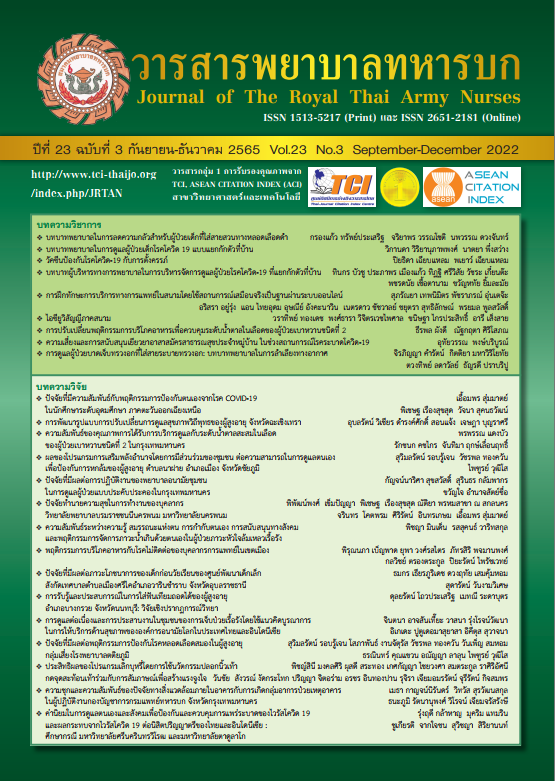Factors Influencing Preventive Behaviors for Cerebrovascular Disease among Elderly Risk Group of Tertiary Hospital
Keywords:
Rick Group, Disease Preventation Behavior, Slroke, Elderly, Tertiary care HospitalAbstract
This research aimed to; 1) Behaviors for cerebrovascular disease among elderly risk group of tertiary hospital 2) study factors Influencing preventive behaviors for cerebrovascular disease among elderly risk group of tertiary hospital The sample consisted of 136 among elderly risk group of tertiary hospital. The research instrument was a questionnaire composed of 5 parts: demographic data, stroke knowledge, risk perception factors, severity of stroke, perceived benefits and obstacles to stroke prevention practices, social support and stroke preventive behaviors. The content validity index of a questionnaire was 0.88 and Knowledge questionnaire finds KR - 20 equal to 0.82, the reliability coefficients of each sub-parts, were 0.84, 0.81, 0.86 and 0.86 respectively. Descriptive statistics and Stepwise multiple regression analysis were used in data analysis. Statistical significance was set at the level of .05
The results were as follows. among elderly risk group of tertiary hospital, knowledge of cerebrovascular disease was at the high level with 43.4 percent. risk perception factors showed the moderate level of 71.3 percent. severity of stroke factors showed the high level of 86.1 percent. perceived benefits factors showed the moderate level of 52.2 percent. and obstacles to stroke prevention practices factors showed the moderate level of 45.6 percent. Social Support communication factors showed the moderate level of 54.4 percent , family factors showed the moderate level of 69.1 percent, neighbor factors showed the moderate level of 63.2 percent, staff personnel factors showed the high level of 56.6 percent and preventive behaviors for cerebrovascular disease showed the moderate level of 89.7 percent. Factors associated with perceived severity of disease (B = 0.080) and social-emotional and family support (B = 0.109) can jointly predict stroke prevention behaviors in the elderly, at risk groups, tertiary care hospitals in overall 8.8 percent of the variance of stroke preventive behavior at p <.05.
Downloads
References
Department of Disease Control. Information from a report from the Office of Policy and Strategy. Office of the Permanent Secretary, Ministry of Public Health. Nonthaburi: Health System Development Group Bureau of Non-Communicable Diseases; 2017. (in Thai)
Feigin VL. Stroke epidemiology in the developing world. Lancet (London,England) 2005; 365: 2160–1.
Strategy and Planning Division. Office of the Permanent Secretary, Ministry of Public Health. Public health statistics. Nonthaburi: Strategy and Planning Division; 2019. (in Thai)
Strategy and Planning Division. Bureau of Non-communicable Diseases. Annual Report 2016. Bangkok: Office of Printing Works Veterans Relief Organization under the royal patronage; 2016. (in Thai)
International Health Policy Development Agency. Report on the Burden of Disease and Injury of the Thai Population 2014. Nonthaburi: The Graphico Systems; 2017. (in Thai)
Institute of Neurology, Department of Medicine, Ministry of Public Health. Nursing Guidelines for Stroke Patients For general nurses. Bangkok: Thana Press; 2016. (in Thai)
Nilnate N. Risk Factors and Prevention of Stroke in Hypertensive Patients. Journal of The Royal Thai Army Nurses, 2019; 20(2): 51-57. (in Thai)
Chanaphan Y. & Settheetham D. Factors Associated with Stroke Prevention Behavior among Hypertension Patients in Kumpawapi District, Udon Thani Province. Journal of Sakon Nakhon Hospital. 2018; 21(2): 109-119. (in Thai)
Kumpangkaew K. Somboontanont W. & Leelahakul V. Relationships between Perceived Risk, Perceived warning signs and self-care behavior in Older adults at risk of Cerebrovascular Disease. Nursing Journal of the Ministry of Public Health.2015; 25(2): 40-56. (in Thai)
Carod-Artal FJ, Egido JA. Quality of life after stroke: the importance of a good recovery. Cerebrovascular Diseases (Basel, Switzerland). 2009; 27: 204- 14.
Becker, M. H., & Maiman, L. A. The health Belief Model: Origins and Correlation in Psychological Theory. Health Education Monography; 1975. 2. Winter: 336-385.
House, J.S. Work Stress and Social Support. Reading, Mass: Addison-Wesley; 1981.
Non-communicable disease office Department of Disease Control. World Paralysis Day Campaign Message Issue 2014 (fiscal year 2015). Nonthaburi: non-communicable disease office Department of Disease Control; 2015. (in Thai)
Krejcie, R. V. & Morgan, D. W. Determining Sample Size for Research Activities. Educational and Psychological Measurement; 1970, 30(3): pp. 607-610.
Tijayoung S. The Factors Influencing Preventive Behaviors Amongst Risk Group Stroke Patients. Master of Nursing Thesis. (Department of Community Medicine Nursing). Nakhon Pathom: Christian University. 2014. (in Thai)
Best, J. W. Research in Education. (3 rded). New Jersey: Prentice hall Inc.;1977.
Watcharanurak P. & Klubklay A. Factors Influencing Preventive Behavior among Stoke-Risk Patients in Songkhla Province. The Southern College Network Journal of Nursing and Public Health .2017; 4 (1): 217-232. (in Thai)
Downloads
Published
How to Cite
Issue
Section
License
Copyright (c) 2022 Journal of The Royal Thai Army Nurses

This work is licensed under a Creative Commons Attribution-NonCommercial-NoDerivatives 4.0 International License.
บทความหรือข้อคิดเห็นใดใดที่ปรากฏในวารสารพยาบาลทหารบกเป็นวรรณกรรมของผู้เขียน ซึ่งบรรณาธิการหรือสมาคมพยาบาลทหารบก ไม่จำเป็นต้องเห็นด้วย
บทความที่ได้รับการตีพิมพ์เป็นลิขสิทธิ์ของวารสารพยาบาลทหารบก
The ideas and opinions expressed in the Journal of The Royal Thai Army Nurses are those of the authors and not necessarily those
of the editor or Royal Thai Army Nurses Association.






